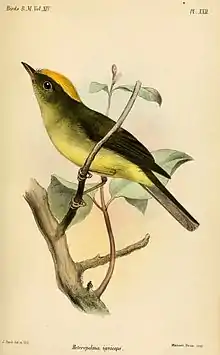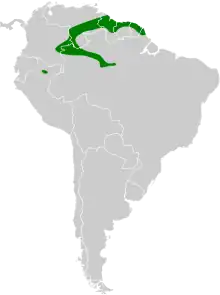Saffron-crested tyrant-manakin
| Saffron-crested tyrant-manakin | |
|---|---|
 | |
| Scientific classification | |
| Domain: | Eukaryota |
| Kingdom: | Animalia |
| Phylum: | Chordata |
| Clade: | Dinosauria |
| Class: | Aves |
| Order: | Passeriformes |
| Family: | Pipridae |
| Genus: | Neopelma |
| Species: | N. chrysocephalum |
| Binomial name | |
| Neopelma chrysocephalum (Pelzeln, 1868) | |
 | |
Taxonomy
Taxonomically, the Saffron-crested Tyrant-Manakin belongs to the Pipridae family, which includes various manakin species, all known for their unique characteristics and behaviors. It was named by August von Pelzeln in 1868. The Spanish name for this species is Saltarín-Tirano de Cresta Azafrán.
Description
It's a small short-tailed manakin, with a light yellowish breast; it looks very similar to a flycatcher. One of the most notable features of the Saffron-crested Tyrant-Manakin is its saffron yellow crest that stands on its head. This crest is similar to the bird's plumage, making it a sight to see within the dense rainforest. This appearance is one of the key identifying characteristics of the species. It has a very nasal call with a variety of repeated "wraaang", "skeeehh" and 'eerhhh" sounds.
Distribution and habitat
It is found in the Guianas, southern Venezuela and the northwestern Amazon Basin. Its natural habitats are tropical forests and shrubland.
The range in northern South America is the coastal Guianan region extending into coastal northeastern Brazil, the north of Amapá state. The range extends westward from Guyana into southeast Venezuela, eastern Colombia and then extends southeasterly down the Rio Negro (Amazon) river wildlife corridor to the Amazon River and then to the Madeira River, it also goes upstream on the Amazon River 250 km to the Purus River.
In the Amazon Basin, the North Region, Brazil, the species is in the states of Amapá, Amazonas, and very southern Roraima. Populations are in northern Peru along river headwaters, (the region of the Ucayali River).
These birds are generally found in the tropical rainforests, particularly in countries such as Brazil, Peru, and Bolivia. While their saffron crests are eye-catching, these birds are known for their reserved and shy behavior. They have a tendency to hide in areas of the rainforest, which makes them challenging for birdwatchers to spot. This behavior makes these birds much more interesting, as many bird enthusiast's eager are much more eager to catch a glimpse of this bird. The preferred habitat of these birds are located in the tropical rainforests. However, this habitat is under threat due to deforestation and habitat damage in the Amazon rainforest. Conservation efforts are important to ensure the continued survival of this species and the preservation of their behaviors.
Reproduction
Cooperative breeding is another remarkable feature of this species. Saffron-crested Tyrant-Manakins engage in cooperative breeding. This means that groups of individuals, including non-breeding males, actively participate in the offspring produced by a dominant breeding pair. This behavior is relatively rare among birds and adds an interesting dimension to their social structure and dynamics.
One of the most intriguing aspects of these birds is their fascinating displays. During the breeding season, male Saffron-crested Tyrant-manakins gather on specific grounds. Here, they engage in dance routines that involve acrobatic jumps, intriguing displays, and a variety of distinctive bird calls aimed at attracting females. These rituals are interesting to witness in the wild and are a reflection of the complex mating behaviors.
Diet
When it comes to their diet, Saffron-crested tyrant-Manakins primarily feed on insects, small fruits, and berries. They search for their meals within the forest and are known for their quick ability to catch insects.
References
- BirdLife International (2016). "Neopelma chrysocephalum". IUCN Red List of Threatened Species. 2016: e.T22701173A93816337. doi:10.2305/IUCN.UK.2016-3.RLTS.T22701173A93816337.en. Retrieved 11 November 2021.
External links[3]
- Photo-High Res; Article--Highest Res https://www.nhlstenden.com/"Suriname Birds"
- "Saffron-crested Tyrant-Manakin - eBird". ebird.org. Retrieved 2023-10-24.
- "Saffron-crested Tyrant-Manakin (Neopelma chrysocephalum)". Peru Aves. 2023-04-23. Retrieved 2023-10-24.
- Snow, David (2020). "Saffron-crested Tyrant-Manakin (Neopelma chrysocephalum), version 1.0". Birds of the World. doi:10.2173/bow.sctman1.01species_shared.bow.project_name. ISSN 2771-3105.
